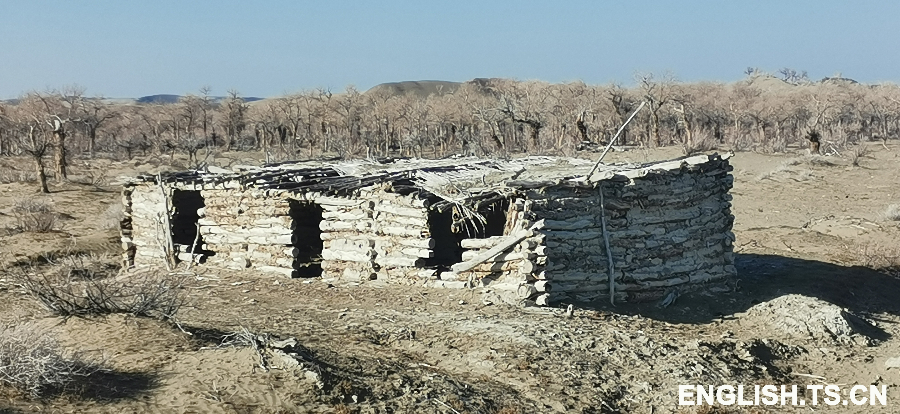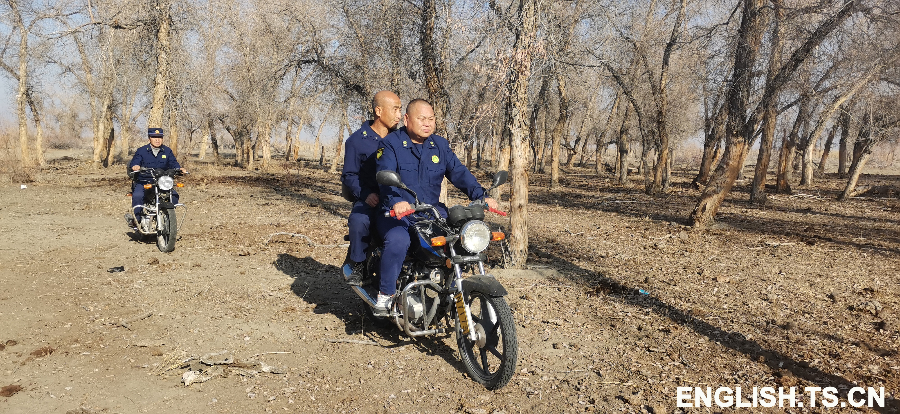Tianshannet-Xinjiang Daily (Reporter Reyida) news: It was a chilly morning in early winter in Usu City, although there was no snow. Pulling our coats around us, we got into the car to head west. More than 100 kilometers away from downtown, a fascinating winter landscape came in sight – the blue skies with fluffy white clouds, the prodigious snow-capped mountains in the distance, and the neatly stacked golden bales on the cotton fields.
I was reveling in the beautiful views outside the window. “Look! Goitered gazelles,” exclaimed Yan Jianhua, head of Ganjiahu Forest Nature Reserve in Usu City. I looked in the direction in which his hand was pointing and saw four goitered gazelles beside the expressway. “We are now within the boundaries of the Nature Reserve. In the past, we could only see this species deep in the forest. Now there are more wild animals, so it’s not surprising to see them around,” explained Yan Jianhua.
Since Ganjiahu Forest Nature Reserve was established in 1966, generations of rangers have been dedicated to protecting the forest with a total area of 3,919,200 mu (261,280 hectares). They are responsible for day-to-day work such as forest control, forest and woodland resources conservation, wildlife protection, and grassland conservation. Their work has helped prevent the southward and eastward expansion of the Gurbantunggut Desert, the second largest desert in China.
“We are the third-generation rangers”
After travelling for 90 minutes and passing through a desert shrubland, we came to Mayisu Station, the first conservation and stewardship station in the west of Ganjiahu Forest Nature Reserve.
As soon as we entered the room, we felt so cozy that we took off our thick coats. “The working conditions are much better now. The station has heating, internet access, air conditioning, and TV, which the generations of my father and grandfather couldn’t even imagine,” said Jing Daoqiang, head of the station.
“Were your father and grandfather rangers as well?” “We are both third-generation rangers,” answered Jing Daoqiang, pointing towards Mulali Aibixi standing next to him.
Yan Jianhua introduced that there are 18 conservation and stewardship stations (points) in Ganjiahu Forest Farm, and 12 of the 136 rangers are the third generation of their family in this line of work.
Ganjiahu Forest Nature Reserve is located in the western Junggar Basin and in the northwest of Usu City. It stretches westward from the western canal in the 125th Regiment of Huyanghe City, the XPCC (Xinjiang Production and Construction Corps) 7th Division to Wudaoquan in Jinghe County, and borders Guertu Ranch in Usu City on the south and Beishan of Toli County on the north. It takes at least one hour to drive from Ganjiahu Forest Nature Reserve to downtown.
“It took about one day to go to downtown before the year 2000. Patrolling the forest was even more challenging. Grandpa and his colleagues traversed the region on horseback. They carried dried food with them as the patrols would last an entire month. In my father’s generation, they rode a horse or bicycle and would be away for half a month or so. At that time, the stations were semi-underground caves or wood cabins, which were barely furnished or equipped,” said Jing Daoqiang.

Wooden houses built at the Ganjiahu Forest Nature Reserve in Usu City,northwest China's Xinjiang Uygur Autonomous Region in the 1990s. (Photo by Liu Jianping)
Inspired by the older generations working in harsh conditions, Jing became a ranger in 2002. “The first station I worked at was called ‘station 86’. Except for a dozen colleagues, I barely met anyone else for a month. One day, we saw a herdsman riding a motorcycle in the distance. A dozen of us squatted in a row at the door, watching the man in excitement,” said Jing Daoqiang with an innocent smile.
It may sound romantic to roam around the vast forest every day and observe the different views in each season, but it is practically a grind. “There was no electricity at the station before 2003. A dozen of us patrolled in the daytime and after we came back in the evening, we simply read books or had a chat. After some time, we didn’t even know what else to talk about,” recalled Mulali.
Since 2003, the conditions have been gradually improved. The Nature Reserve has built an additional 158 kilometers of roads and provisioned rangers with patrol tools such as intercoms, body cameras, navigation devices, and motorcycles. It has also built warehouses for fire protection materials with a total investment of over RMB 10 million and set up emergency response teams. High-altitude platform systems and drones have been deployed to achieve smart forest management. For the past 10 consecutive years, there have been no incidents of forest or steppe fires, nor occurrences of forest pest disasters.
“Here is where our happiness lies”
“My mother’s brother and my eldest brother also work in the Nature Reserve, and my uncle’s son wants to apply for a job at the Reserve, too.” Mulali finally got the chance to jump in.
Like Jing Daoqiang, he was born in the Nature Reserve, and their fathers are good friends. “We hung out together in the Nature Reserve since we were kids and are now colleagues,” added Mulali.
“You saw how hard the older generations were working in the Nature Reserve. Why did you still choose to be a ranger?”
“Here is where our happiness lies.”
Ganjiahu Forest Nature Reserve, situated amidst diverse landscapes, features vast expanses of the Gobi desert along with dotted wetlands and lakes. It is home to numerous desert plants tolerant to drought and saline-alkali stress, a variety of wild animals, and birds that live in or near the lakes and wetlands. The rangers have to stay in the Nature Reserve all year round and patrol the forest on a motorcycle every day, even in the fierce sun. Apart from the countless desert plants and roaming wild animals, what exactly is interesting about this job? In the eyes of others, the job is the equivalent to hard labor, loneliness, and danger. How could the rangers feel happy?
When these were going through my mind, Mulali sat next to me and began to show me the photos on his phone. “These three lynxes are one family. I took the photo in September, and it is the first time I have ever seen a lynx. Check out these goitered gazelles, whooper swans, and black storks photographed by my colleagues.” Mulali went on at great length about the photos.

Zhao Zhenxing, head of the Ganjiahu Forest Nature Reserve in Usu City, northwest China's Xinjiang Uygur Autonomous Region, and his colleagues patrol the area. (Photo by Liu Jianping)
“Our greatest joy is to ‘show off’ what we see at work.” Mulali said that whenever they see wild animals or beautiful views on patrol, they would take pictures immediately.
“In the old days, it was by luck for one to spot wild animals because they usually hung out deep in the forests. But now, things are different - we not only come across them more often, but also observe more species,” said Yan Jianhua.
“And not just the wild animals that have grown in number, take my patrol zone as an example, part of the land used to be barren, but now, sacsaoul and Euphrates poplar grow in many areas, and the vegetation coverage is increasing,” Jing Daoqiang chimed in.
Yan Jianhua added that although they have not invited specialized personnel to monitor the data in recent years, the rangers have observed the changes and known them by heart.
“The environment is steadily improving”
“It’s the cotton farmers in surrounding villages who have benefited from the forest most.” Yan Jianhua led us to Tongliu Village of Guertu Town, two kilometers away from Mayisu Station.
In the village, we met a villager named Liang Zhongxin, who was picking up straw in the cotton field. Liang Zhongxin and his family grow 50 mu (3.3 hectares) of cotton this year, with cotton yield per mu exceeding 450 kilograms. “In recent years, the environment has kept improving. There have been few sandstorms, and no crop failure has occurred,” noted Liang.
Ganjiahu Forest Nature Reserve is located in the middle of the Gurbantunggut Desert. For decades, the surrounding areas had suffered from sandstorms caused by the northwest winds that came from Alashankou. “In April and May, shortly after the cotton seeds were sown, the strong winds would blow the mulch film away, and we had to do it all over again. When the seedlings emerged, the winds would blow down the seedlings. I remember that cotton crop failures occurred in the 1990s,” said Liang.
Cotton farming has a long history in Usu City, the largest cotton producer in northern Xinjiang. This year, the total area of cotton cultivation in the city amounts to 1,742,500 mu (16,167 hectares). “In the past, sandstorms had destroyed not only the cotton fields around the forest farm but also in the wider Usu City,” said Hu Rui, an official of the Publicity Department of the CPC Usu Municipal Committee.
Ganjiahu Forest Nature Reserve has played a vital role in preventing crop failures and ensuring bumper harvests.
“Our Nature Reserve and Alashankou are more than 70 kilometers apart as the crow flies. When the northwest winds blown from there reach the desert, sand is lifted from the ground, swirling and dancing in chaotic patterns. The forest of over 3.91 million mu (260,667 hectares) serves as the shields against the wind and sand. In the past, the vegetation was degraded and the environment deteriorated owing to various reasons, which had a huge impact on production and life. Now the environment is getting better and better,” said Yan Jianhua, looking at the vast sacsaoul forest in the distance.
“We now have a new problem,” said Liang Zhongxin, scratching his head. There are more and more wild boars, hares, and pheasants; and goitered gazelles often hang out, causing damage to the crops sometimes. “They are our flurry friends. We cannot hurt them but find some means to drive them away. We need to learn how to get along better with them,” added Liang with a smile.









